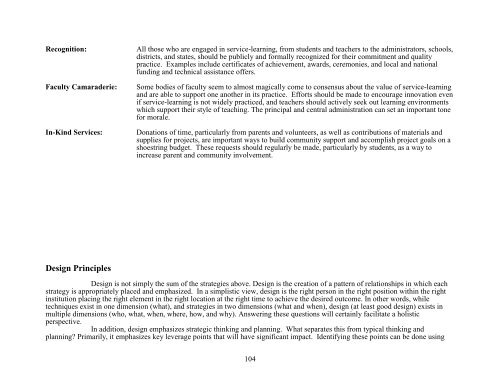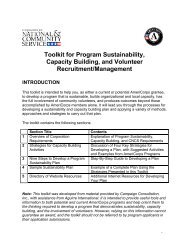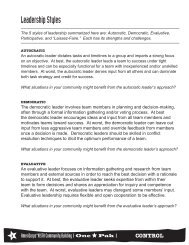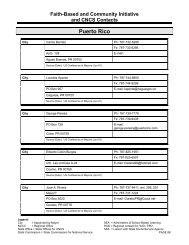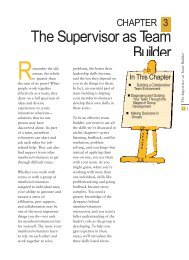MAKE IT LAST FOREVER: THE ... - National Service Resource Center
MAKE IT LAST FOREVER: THE ... - National Service Resource Center
MAKE IT LAST FOREVER: THE ... - National Service Resource Center
You also want an ePaper? Increase the reach of your titles
YUMPU automatically turns print PDFs into web optimized ePapers that Google loves.
Recognition: All those who are engaged in service-learning, from students and teachers to the administrators, schools,<br />
districts, and states, should be publicly and formally recognized for their commitment and quality<br />
practice. Examples include certificates of achievement, awards, ceremonies, and local and national<br />
funding and technical assistance offers.<br />
Faculty Camaraderie: Some bodies of faculty seem to almost magically come to consensus about the value of service-learning<br />
and are able to support one another in its practice. Efforts should be made to encourage innovation even<br />
if service-learning is not widely practiced, and teachers should actively seek out learning environments<br />
which support their style of teaching. The principal and central administration can set an important tone<br />
for morale.<br />
In-Kind <strong>Service</strong>s: Donations of time, particularly from parents and volunteers, as well as contributions of materials and<br />
supplies for projects, are important ways to build community support and accomplish project goals on a<br />
shoestring budget. These requests should regularly be made, particularly by students, as a way to<br />
increase parent and community involvement.<br />
Design Principles<br />
Design is not simply the sum of the strategies above. Design is the creation of a pattern of relationships in which each<br />
strategy is appropriately placed and emphasized. In a simplistic view, design is the right person in the right position within the right<br />
institution placing the right element in the right location at the right time to achieve the desired outcome. In other words, while<br />
techniques exist in one dimension (what), and strategies in two dimensions (what and when), design (at least good design) exists in<br />
multiple dimensions (who, what, when, where, how, and why). Answering these questions will certainly facilitate a holistic<br />
perspective.<br />
In addition, design emphasizes strategic thinking and planning. What separates this from typical thinking and<br />
planning? Primarily, it emphasizes key leverage points that will have significant impact. Identifying these points can be done using<br />
104


